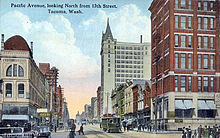In 1852, a Swede named Nicolas Delin constructed a sawmill powered by water on a creek near the head of Commencement Bay, but the small settlement that grew up around it was abandoned during the Indian War of 1855–56. In 1864, pioneer and postmaster Job Carr, a Civil War veteran and land speculator who hoped to profit from the selection of Commencement Bay as the terminus of the Transcontinental Railroad, built a cabin (a replica of Job Carr's cabin, which also served as Tacoma's first post office, was erected in "Old Town" in 2000 near the original site), and later sold most of his claim to developer Morton M. McCarver (1807–1875), who named his project Tacoma City, derived from the indigenous name for the mountain.
Tacoma was incorporated on November 12, 1875, following the merger of Old Tacoma and New Tacoma on January 7, 1884. Its hopes to be the "City of Destiny" were stimulated by selection in 1873 as the western terminus of the Northern Pacific Railroad, thanks to lobbying by McCarver, future mayor John Wilson Sprague, and others. The transcontinental link was effected in 1887, but the railroad built its depot on "New Tacoma", two miles (3 km) south of the Carr-McCarver development. The two communities grew together and joined. The population grew from 1,098 in 1880 to 36,006 in 1890. Rudyard Kipling visited Tacoma in 1889 and said it was "literally staggering under a boom of the boomiest".[12]
The Commencement Bay Land and Improvement Co. played a major role in the city's early growth.
In November 1885, white citizens led by then-mayor Jacob Weisbach expelled several hundred Chinese residents peacefully living in the city. As described by the account prepared by the Chinese Reconciliation Project Foundation, on the morning of November 3, 1885, "several hundred men, led by the mayor and other city officials, evicted the Chinese from their homes, corralled them at 7th Street and Pacific Avenue, marched them to the railway station at Lakeview and forced them aboard the morning train to Portland, Oregon. The next day two Chinese settlements were burned to the ground."
The discovery of gold in the Klondike in 1898 led Tacoma's prominence in the region to be eclipsed by the booming development of Seattle.
20th century
A major tragedy marred the end of the 19th century, when a streetcar accident resulted in significant loss of life on July 4, 1900.
Downtown, early 20th century
Tacoma was briefly (1915–22) a major destination for big-time automobile racing, with one of the nation's top-rated racing venues located just outside the city limits, at the site of today's Clover Park Technical College.
The Great Depression
The 1929 crash of the Stock Market, also known as the Great Depression, was only the first event in a series of bad misfortunes to hit Tacoma in the winter of 1929–30. One of the coldest winters on record, Tacoma experienced mass power outages and eventually the shutdown of major power supply dams, leaving the city without sufficient power and heat. [16] During the 30-day power shortage in the winter of 1929 and 1930, Tacoma was provided with electricity from the engines of the aircraft carrier USS Lexington.[17][18]A power grid failure paired with a newly rewritten city constitution put in to place in order to keep political power away from a single entity such as the railroad, created a standstill in the ability to further the local economy. Local businesses felt the pinch as the sudden stop of loans limited progression of expansion and renewal funds for maintenance leading to foreclosures. [19] Families all over the city experience the fallout of economic depression growing the problem of "where" and "how" breadwinners were going to find the food that their families needed to survive. Local makeshift inner shanty town politics began to develop as the occupants needed some form of leadership to keep the p


No comments:
Post a Comment